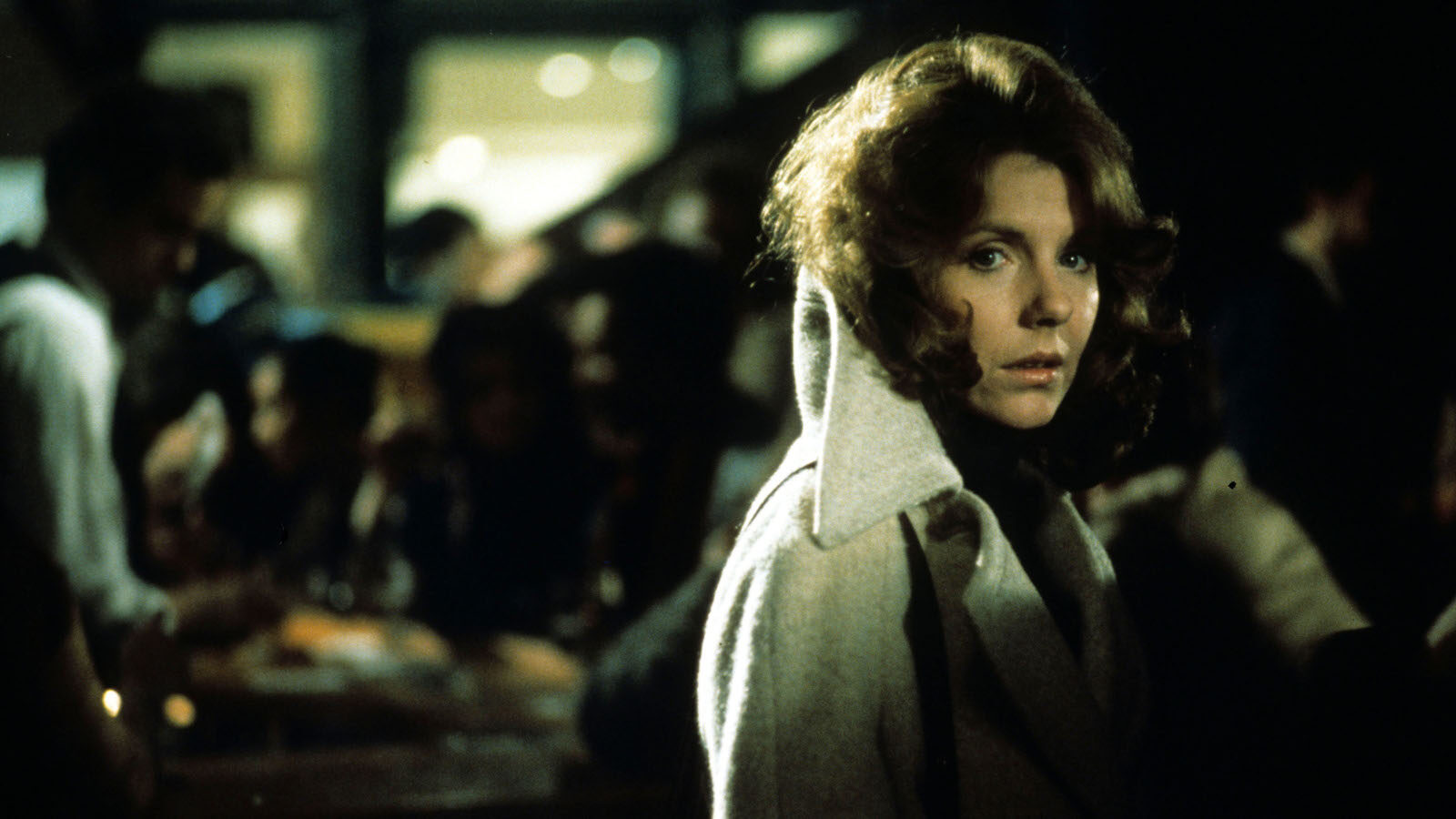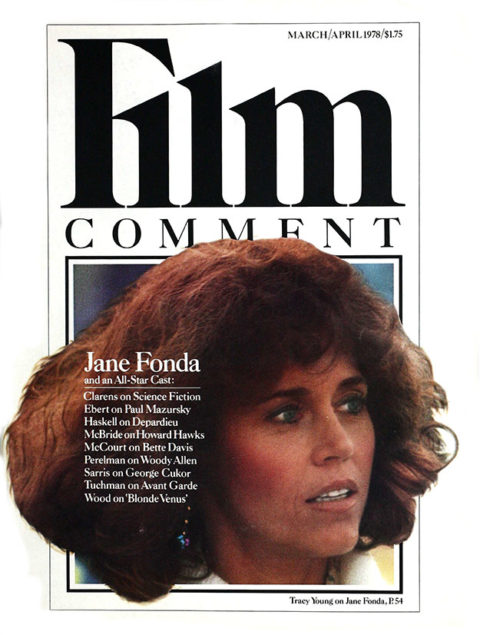By Roger Ebert in the March-April 1978 Issue

An Unmarried Woman
A Man and a Woman
Balls, said the Queen—
If I had ’em I’d be King.

From the March-April 1978 Issue
Also in this issue
The line comes at the end of a long and unhappy passage: Jill Clayburgh, staring at herself in a mirror, haggard and drained after learning that her husband is leaving her, pitiless in her self-assessment. I was deeply affected by the scene, and at the same time I found myself wondering how Paul Mazursky was going to end it. A slow fade to black would be obvious, and unsatisfactory. But what could she possibly say? What was the right line, the right tone? Mazursky had to go way out into left field to find her speech, all right, but he found it, and it works: it gives us the release we need, and sets Clayburgh’s personality for the movie’s second act, the scenes of bitterness, loneliness, and then pluckiness and the beginnings of emotional recovery.
Mazursky finds the right tone again and again An Unmarried Woman. And it’s not always very easy to find, because he wants to make his film both true and funny, not sacrificing the laughs for the truth. That was the way with the early satirical cabaret companies he worked in, the West Coast groups influenced by the first Second City generations (Nichols and May, Barbara Harris, Severn Darden, Andrew Duncan). The humor had to work twice, first for the laugh and then to cut more deeply. And his films, much more than the latter-day spinoffs like Saturday Night Live, preserve the insights and integrity of the late-Fifties American comedy breakthrough.
Mazursky has never before made a film as good as An Unmarried Woman, though—but then few American directors of recent years have. He’s never quite gotten through an entire movie before without losing the tone at some point, maybe because it is so hard to make audiences laugh, care, and think at the same rime. He came closest in Blume in Love, with George Segal so hopelessly trying, really trying, to figure out why his wife should enjoy the same sexual freedom he took for granted for himself.
An Unmarried Woman resembles Blume in Love not only in its insight and precise observation of behavior, but also with the emotional satisfactions it provides—Mazursky isn’t afraid to pull out all the romantic stops at the right moment. He wants to record the exact textures and ways of speech and emotional complexities of his middle-class Americans, and he wants to point out the empty places and the hiding places in their lives. But he’s not a slice-of-life artist. He starts from real, but sooner or later he arrives at a release, and the movie depends on how well he controls the release.
Next Stop, Greenwich Village trailed off, I thought, because it finally didn’t know exactly what it thought, now, about those people of all those years ago. Harry and Tonto finally lost the charm of Art Carney’s crustiness in an ending too soft and sentimental. But Blume in Love, with its absolutely uninhibited romantic conclusion (George Segal and Susan Anspach running across the Piazza San Marco and into each other’s arms to the Love Theme from Tristan and Isolde), provided the release it had earned.
And now, in An Unmarried Woman, Mazursky has prepared his ground so carefully that we not only care but even believe when Jill Clayburgh falls in love with a sexy, cuddly, rich, famous, eccentric British artist. Alan Bates was the perfect casting here, and the Clayburgh character has been so wonderfully realized that we’d even buy it if she met and fell in love with Alan Bates as himself.
There are scenes in An Unmarried Woman so well written and acted that our laughter is unsettling, the laughter of exact recognition. Women friends tell me that the first meeting of Clayburgh and her “club” of three old girlfriends is presented with precise accuracy; all the words and attitudes ring true (especially in the discussion of the older woman’s new nineteen-year-old lover: “She doesn’t know whether to fuck him or adopt him”). The scene with the four women in the bar sounds right, too, and when Mazursky has them all sprawled on a bed, leafing through the Sunday Times and the photographs of great movie stars, the interplay between their fantasies about actresses and their realizations about themselves is so revealing it hurts.
If the scenes involving the four women are the movie’s best, the interplay between Clayburgh and her daughter (Lisa Lucas) is also wonderfully well understood. Remember the way, for example, that the daughter waits until her mother is bringing Alan Bates home to dinner before springing the news about the girl at school who had an abortion: There’s not just an unspoken threat here, but an unspoken fear. And Mazursky’s ear is perfect in such lines by the daughter as, “We saw the new Lina Wertmuller film. I thought it was good, but Phil thought it was flawed.”
Great thought, care, and love must have gone into the writing of An Unmarried Woman, which Mazursky says evolved gradually in his imagination as he began to observe the divorced women in his and his wife’s own circle of friends. But great courage went into the acting, too: Jill Clayburgh takes chances here, and never seems concerned about protecting herself, and reveals as much in a character as anyone has since some of Liv Ullmann’s work for Ingmar Bergman. The luminosity I found in her performance was all the more joyful because, frankly, I hadn’t taken her very seriously before. Gable and Lombard was a turgid mess, and Silver Streak and Semi-Tough weren’t structured to demand revelation or subtlety. Friends said Clayburgh was good in Hustling, made for TV, but I missed it.
Now, suddenly, here she is, creating one of the great recent performances. It’s a lesson for the critics on the dangers of assessing performance in a movie, a medium in which the actors may be more at the mercy of the other craftsmen than we can easily see. Mazursky tested Clayburgh before, he says, for Blume in Love and Next Stop, Greenwich Village. He always thought she had something. This time he decided to go with his intuition, and he was spectacularly right.
What does the movie say, really say, about women in our society? I don’t think it’s a message picture—I missed the message, anyway. I think it’s supposed to make us feel what this woman in this situation (and therefore many women in many situations) might go through when a “happy” marriage ends and the husband leaves for another woman. The movie is wise to spend enough time at the top establishing the marriage as an apparently happy one; the sex between Clayburgh and Michael Murphy, as her husband, is as easy and familiar as it is occasionally erotic, and what a great touch it was to throw in her impromptu living-room performance in Swan Lake as a coda to orgasm. (A later coda, the ice-skating scene in Rockefeller Plaza, is one of the movie’s few real missteps.)
But then the happiness ends, and Murphy, crying on the sidewalk, blurts out the truth about this affair he’s been having. Mazursky again finds just the right line (about their daughter: “You tell Patti”), although he follows it with an anticlimactic one (“Tell me one thing: Was she a good lay?”). And then Clayburgh has her meditation on kings and queens and faces living without a husband.
The three close girlfriends are pretty obviously intended by Mazursky to represent a spectrum of possible reaction to the spectre of being suddenly “unmarried” in their thirties. He lines them up in the bar scene, left to right on a diagonal sloping downward toward the strong axis just right of center, and has them argue their cases. On the extreme left, there’s the most negative friend (“Hire a good lawyer and sue the son of a bitch for everything he’s worth”). Next, at neutral center-screen, is Clayburgh. On the strong axis is the friend who thinks things can be worked out. To the right of her, in a slightly weaker screen position, is the friend who thinks the husband was kinduva nice guy.
Her possible reactions: Which should she choose? The scenes with the woman psychiatrist again walk a thin line between the truth of transparent sincerity and Mazursky’s ability to be very shyly satirical. Who, having had anything to do with shrinks, can fail to smile at “I think for right now you should come twice a week, but then after a while once a week, because it’s what happens to you out there, not in here, that’s important”—while the General Electric clock measures out 55 minutes in the psychiatrist’s direct sight line?
Clayburgh’s decision to enter the singles-bar jungle is also a walk through a minefield; there are so many ways the movie could go wrong here. But Cliff Gorman, pelted with body hair, possessor of a good line of basic singles-bar bullshit, turns out to be the movie’s correct solution: “Relax, the foot doctor’s here,” he says after she gets a splinter in her toe from the floor of his loft. And then, again, Mazursky finds the right line, or tone, to end a difficult scene: How does she behave in bed? Why, she laughs—and then she finds the sexual excitement. The scene could have ended with her exit, but there’s something gentle and even quietly troubling about the way Mazursky stays in the loft long enough to show Gorman, alone again, looking out the window and…lighting a pipe.
The third act, the scenes with Alan Bates, are perhaps the trickiest in the film. There’s the temptation to accuse Mazursky of an improbably happy ending: As a lot of people observed about Alice Doesn’t Live Here Anymore, it’s just not very likely that a Coca-Cola driver’s widow would stumble into Kris Kristofferson as a genial rancher. But I think Mazursky was right to go for a large romantic gesture, and to present it so baldly (“Let’s discuss it over lunch” is Bates’ laconic opening ploy). Where the picture shows its stubbornness is in refusing to let Clayburgh go off to Vermont with Bates for the summer: Having given herself to one man, unwisely as it turned out, she will now keep permanent possession of herself. She has to take two chances: the chance of falling in love, and the chance that Bates won’t settle for less than all of her. She takes her chances, keeping her independence while shouldering as well the burden of his dependence on her (and the final shots are the visualization of her choice).
An Unmarried Woman is such a good picture not because it states vast truths about men and women but because it finds that there are none; its heroine and, maybe the rest of us, are in a muddle most of the time, and depend more than we’d want to admit on old friendships, white wine, and quiet desperation to get us through. Having established that point, Mazursky then goes on to provide hope—or Alan Bates, anyway. And he does it in a movie so firmly in control of its language, its body movement, its personal interplays, its most fleeting facial expressions (remember the daughter’s dubious little sniff?) that we’re touched by real human sensibilities here. Bergman is the greatest maker of films about Woman; in this one, Paul Mazursky and Jill Clayburgh discover beautiful and worthy things about women.







